Friday, October 22, 2010
Mark Twain has a new book out!
Sunday, September 26, 2010
A poem of a cemetery spot
In a distant cemetery
at the corner of the lot
Lies buried and forgotten,
a little Irish tot.
The site once had a marker
that told a name and date:
Isabell Ryan,
born nineteen eight.
Her father made a cross to show
his little girl his love,
Was Christan born and baptised,
Bless the living God above.
Her family was not well to do
they had no time to choose,
a proper site, she died so fast,
just barely in her twos.
The grave-yard people deemed
the homemade crosses crude,
They tore them down, left Isabel,
in lonely solitude.
It just seems awful tragic
That this little girl should be
away from all the folks she knew,
Her friends and family.
I know she isn't really there
It's just her little bones.
Her soul has traveled far up high
To God's almighty thrones.
And still sometimes I travel there,
Down a dusty road, rutted trail,
There's wild flowers growing around
Birds sing on the rail.
I have a special interest there,
in this story I tell,
For she's my private little Saint,
She's my "Auntie Isabel".
Thursday, August 5, 2010
Edith Mae, Hank and Friends Walk Through History

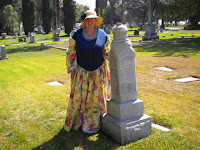.jpg)
Friday, July 30, 2010
From My Family Album. Samuel and Jannie Shockey

Tuesday, July 27, 2010
Tombstone Tuesday, Lucy and Me
.jpg)
Saturday, July 24, 2010
From My Family Album, Fred and Grace Boller
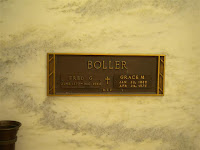.jpg)
Wednesday, July 21, 2010
Before it was History, it was News

This picture was taken at the Corning Public Library in Corning, New York. It was taped near the microfilm reader.
Newspapers are my favorite research source. You may not be able to find the information you want anywhere else. It is most valuable for cemetery search. I have found the obvious: obituaries and information about the people that died, but there are always many stories about the local cemeteries in town. You can piece the information together to create a great cemetery history.
Tuesday, July 20, 2010
Jesse Hill, Baseball Coach OBIT. DAY

09/27/93
Jesse T. Hill, whose career as a player, coach and athletic director at USCspanned six decades, died Aug. 31 in Pasadena. He was 86.Hill was USC's head football coach from 1951 through 1956. His 1952 team providedthe Pacific Coast Conference with its first victory over a Big Ten team in theRose Bowl by beating Wisconsin, 7-0.He became athletic director in 1957 and served until 1972. He then became thefirst commissioner of the Pacific Coast Athletic Association, serving until hisretirement in 1978.During Hill's tenure as athletic director, USC won 29 national championships.As a student athlete, he starred in three sports, earning letters in football(1928-29), track (1927-29) and baseball (1930). He played on Trojan footballteams that won the 1928 national championship and the 1930 Rose Bowl. He was areserve USC fullback in 1928 and 1929 on Howard Jones' famed Thundering Herdteams. He was exceptionally fast and, in 1929, led the conference with an averageof 8.2 yards in his 54 carries.Hill was a long jumper on the track team. He ended his track career in 1929 bywinning the long jump at the IC 4- A meet with a meet-record distance of 25 feetand seven- eighths of an inch.He played on the USC baseball team in 1930 and was the leading batter in theCalifornia Intercollegiate Baseball Association with an average of .389.Graduating cum laude in 1930, he signed a professional baseball contract with theHollywood Stars of the Pacific Coast League. In his first at-bat at Wrigley Fieldagainst the Los Angeles Angels, Hill hit a home run.Purchased by the New York Yankees, Hill played for Newark in 1932, St. Paul in1933 and Newark again in 1934 before being called up by the Yankees in 1935.An outfielder, he played in 107 games and batted .293. He was with the WashingtonSenators in 1936, batting .305. Hill played for the Senators and the PhiladelphiaAthletics in 1937. He finished his baseball career with the Oakland Oaks of thePCL in 1938 and 1939.In his off-seasons during his baseball career, Hill began his coaching careerwith stops at Corona High, Riverside Junior College and Long Beach City College.He enlisted in the Navy in 1942 and served until 1946, earning the rank of lieutenant commander.Hill returned to USC in 1946 as freshman football coach and assistant trackcoach. He succeeded the legendary Dean Cromwell as track coach in 1948, guidingthe Trojans to a pair of undefeated seasons and NCAA crowns. He also was USC'strack coach in 1962, following the sudden death of Jess Mortensen, and led theTrojans to a third-place NCAA finish.Hill is survived by a daughter, Mary Bett Carter, and a son, Jess Hill Jr. He had five grandchildren and one great- grandchild.
Monday, July 19, 2010
Isaac Denton Stockton
 Isaac Denton Stockton is buried in Sunnyslope Cemetery in Corona, CA. If he has any relatives nearby I can’t identify them. On the cemetery records the manner of death is “crushed by a sliding wall of clay” at Filmore, California.
Isaac Denton Stockton is buried in Sunnyslope Cemetery in Corona, CA. If he has any relatives nearby I can’t identify them. On the cemetery records the manner of death is “crushed by a sliding wall of clay” at Filmore, California.As I researched him I wondered why he was buried in Corona. He didn’t appear in any Corona census. I checked the family trees at all the popular web sites and none of his family names appeared in the Corona cemetery or on the Corona City Federal census. I was very puzzled.
FamilySearch shows him married to Bernice Leola in 1914. His draft registration shows him single, not widowed, in 1917. However, the draft registration gave me the information I wanted: he did live in Corona. He worked for his father on the farm north of Corona center on Harrison Street.
I love to see the description on the draft registrations. Denton, as he was called, was short, had blue eyes, brown hair and was hard of hearing.
I’ll bring you a flower now and again, Denton.
Saturday, July 17, 2010
Veteran List and Missing Soldier
Kathleen, my cemetery friend, and I have identified 366 veterans buried at Sunnyslope. One for each day of the year plus one more. We typed their names into Excel including the war (Civil War to the current war) that they were identified with, the birth and death dates and any special notes. We have checked and rechecked to make sure we got them all. The list was emailed to the local American Legion Post who is named after one of the veterans on the list, Joe Dominquez.
Of course just when you think you have it perfect, another soldier is identified.
I was telling another good friend about the project. She said “You have my dad, of course?” I must have turned a hundred shades of red. I was at her dad’s funeral, I know about him. I saw the flag that draped his coffin. I see it proudly displayed in his daughter’s home. But he wasn’t on any of the other “official” sources we bashed together to compile the list.
Now I keep wondering who else have we missed. I am keeping my ear close to the ground (pun intended) in case I hear of any more missing men or women.
Monday, July 12, 2010

Monday, June 14, 2010
The Berachah Industrial Home for the Redemption of Erring Girls
.jpg)
The cemetery is located on the campus of UTA (University of Texas at Arlington), but is hidden at the north edge of Doug Russell Park. The names that are on the stones are Infant No, 1, Infant No. 2 and so on. There are some stones that list only the first names of the child, George, Emma or Mary. You see, the babies are mostly the result of unwed mothers living at the home. Some graves are of mothers that died in childbirth.
Rev. James Tony Upchurch founded this home to save these wild girls (how about the boys?). He believed that mother and child should not be separated so he saw to it that the girls learned a trade such as sewing or nursing. After they acquired a trade they could leave and start their lives. They could also stay if they wanted as there was plenty to do at the home. The school had 67 acres, 10 buildings, its own hospital, barn and chapel.
According to some documents the girls were happy. They found meaningful work and everyone there understood their circumstances.
Tuesday, June 1, 2010
Travels to Texas



Sunday, May 9, 2010
The Rabbit Travels
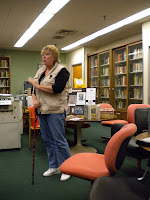
Wednesday, May 5, 2010
Abel White, Found!

I found Abel White about 20 years ago. He is my husband's 3rd great grandfather.
The search continues. Last time I was in SLC I decided to start from scratch and look for him as though I didn’t have a thing on him. The first place I looked was deeds, at the insistence of the friend I was with. I couldn’t believe what I found. I found a document that deeded land from his property for a family cemetery.
On the first part of the document he asked to have a “suitable tombstone to mark my grave after my demise” Then this description of the property is given.
"The following describes parcel of land situated in said County of Franklin and state of Indiana designated by a line drawn from the north west corner of section twenty four of town nine of range two west as established by James N. Clements. Commencing at said corner aforesaid and running east on the north line of said quarter twenty five five rods thence south twenty eight rods to a stone thence west four rods to a stone, and thence north four rods to the first stone (can’t read) corner stone: said above described parcel of land to be held in trust by said Board of Commissioners of Franklin County as a Private Cemetery for the use and interment of the family of the said Abel White"
Signed October 10, 1855
I continued to look but in my heart I knew I needed to make some phone calls. As soon as I got home I did call a few places in Indiana but to no avail. I put the project on the top shelf then continued to other research projects.
A week ago I suddenly had the thought that I had to work on g-g-g-grandpa White. I called the deed office in Franklin Co., Indiana. The lady couldn’t help but offered to give me the name and number of the Historic Society. I called and spoke to this wonderful man that was happy I called. He is also on the Cemetery Commission and one of their projects was to restore the White Cemetery! Talk about being excited. I wanted to act professional and proper but it was hard to resist jumping up and down and calling out many loud cheers.
During the exchange of several emails I learned that the land is currently owned by a man that had bought the land just to use for deer hunting. He had given permission to the Commission to restore the cemetery. I have thought about this so much. Abel White owned many, many acres in his time and that land was used as a family farm and as commodity. To him this was his land and his children’s future. He probably couldn’t imagine a future time that it wasn’t important to someone’s very existence. Can you imagine the difference between what the land means to us in 2010 and what they thought about it in 1855? I always thought that he worked hard to make all the land a prosperous farm. It never occurred to me that he might have used a portion of it to hunt deer too.
Of course he must have thought that the land would always be in his family since he wanted the family cemetery to be there. Forever.
When I got the picture of Abel’s grave from my new friend in Indiana I was beyond thrilled!! I am sure I research family history just as an excuse to find cemeteries.
I still have not been able to find his parents, but I found his grave.
Saturday, April 10, 2010
Lincoln Park Cemetery

There are 10,000 bodies buried under Lincoln Park in Chicago. They have been forgotten for many decades. Perhaps one of us is looking for an ancestor that died in Chicago. This story will deepen the mystery if it doesn’t clear it up.
It is no secret that Lincoln Park was once a cemetery. It began as a cemetery for cholera victims in 1877 because it was considered to be a safe distance from town. There are also 4,000 confederate soldiers that died at Camp Douglas, a POW camp, from awful conditions.
Soon there was a Catholic cemetery, a Jewish cemetery, a pauper cemetery as well as The City Cemetery. At its height there may have been 35,000 graves. Then the Chicago Fire came through and destroyed markers. The official story is that the fire was responsible for graves that were left behind and not reinterred when others were moved to make way for the new park.
Often bones are discovered when routine work is done on the Park or on nearby homes. Most recently (Feb 2010) while a 19th century townhouse was under construction bones were found under a concrete basement floor. They were believed to be from the Old Catholic cemetery. At the same site bones were found in 1947. The Catholic cemetery was sold off in separate lots and sales in the late 1800s.
A terrific researcher named Pamela Bannos has spent an enormous amount of time collecting information to verify, identify and document anything and everything about Lincoln Park’s former identity. Her web site, Hidden Truths, gives any researcher many hours of pleasure digging through all the information she has been able to collect. She provides images of her research and encourages the reader to follow her on her journey of discovering the “Hidden Truths.”
Note: The image above is from Weird Chicago. The tomb is that of Ira Couch.
Maple Grove Cemetery, Valley Center, Kansas
Maple Grove Cemetery in Valley Center, Kansas might just get some attention. It appears from this story that there really are many people buried there without a marker. I am always touched when I discover that a grave is stone-less.
It illustrates that we should never give up when we are looking for our ancestors because maybe some other good soul might discover their final resting place and write about it, list it, log it and place it on Find A Grave or another spot where it can be found again.
Wednesday, March 17, 2010
The Mystery of the Irish at Duffy’s Cut

The Watson brothers think they have found the spot of the grave. A marker was put up in 2004, but the actual site was not known at that time. They are finding many personal items such as buttons, pipes, cooking utensils as well as bones, at a site nearby.
Tuesday, March 9, 2010
Jennie Wade for Tombstone Tuesday
Sunday, March 7, 2010
Ocie Taylor Songer

Tuesday, March 2, 2010
Warkintin Family in Newton, KS for Tombstone Tuesday
.jpg)

Friday, February 26, 2010
Good Graveyard Reading
 I just read the best books by Sarah Stewart Taylor. These stories are about a college professor whose speciality is gravestones, cemetery art and mourning jewelery.
I just read the best books by Sarah Stewart Taylor. These stories are about a college professor whose speciality is gravestones, cemetery art and mourning jewelery.Sweeney St. George, the red headed professor always ends up around a murder mystery that she solves, of course, and along the way teaches the reader about cemeteries.
What's not to love?

Wednesday, February 24, 2010
Maple Grove Cemetery, Valley Center, KS

Tuesday, February 23, 2010
What a difference the years make!
Friday, February 19, 2010
Hotel Cemetery, Fort Worth, Texas
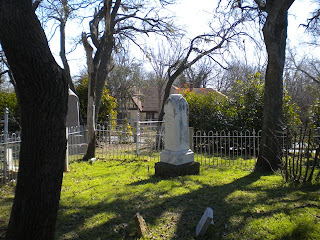.jpg)
.jpg)
An unknown number of plots lie outside the fenced family plot. They include victims of spring fevers and frequent Trinity River floods. None of their fieldstones have survived.
NOTABLE BURIALS - William Alfred Sanderson - A native of England, Sanderson came to Texas in 1841. He obtained a Republic of Texas land grant and settled in Tarrant County with his wife, the former Isabella Frances Ayres. He soon established himself as a farmer and stock raiser. He was a charter member of the Fort Worth First Christian Church and Justice of the Peace and played a role in the relocation of the Tarrant County seat from Birdville to Fort Worth.
New Trinity Cemetery, Fort Worth, Texas
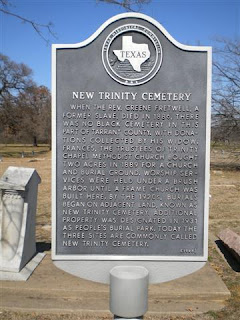.jpg)
New Trinity Cemetery, Fort Worth Texas. This is a all black cemetery. It is not vandelized but neglected. When I got back to my computer I found Cemeteries of Tarrant County. This cemetery needs to be transcribed. Oh I wish I could stay here longer, I would love to do it. But I am on my way to Kansas tomorrow. There are so many neat cemeteries nearby to where I am staying.
Tuesday, February 16, 2010
Irish Gravestone for Tombstone Tuesday
Monday, February 15, 2010
And my new research assistant is...........
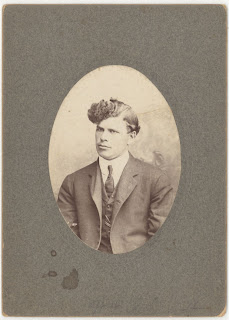

Tuesday, February 9, 2010
Tombstone Tuesday, Archibald Brownlee

Archibald Brownlee was born 12 Jan 1795 and died 10 Sept 1853.
Archibald, son of Thomas and Martha (Shearer) Brownlee, was born on the farm in Buffalo township, Washington county. He was one of the first Abolitionists, and took an active part in smuggling slaves, being interested in the underground railway, which was made to assist the fugitive negro in escaping to Canada.
He is buried in the South Buffalo Cemetery in Washington, PA.
Tuesday, February 2, 2010
Tombstone Tuesday, Amos Walton
Thursday, January 21, 2010
Sunday, January 17, 2010
1930 Census Taker, Bessie Hough

Tuesday, January 12, 2010
Following Her Footsteps
 The picture is of a rock with Indian writing called "Painted Rock". It was moved for a railroad track.
The picture is of a rock with Indian writing called "Painted Rock". It was moved for a railroad track.Thursday, January 7, 2010
DAR Dedication for Janet Gould


Janet Gould was honored yesterday for her work in the Auranta Chapter of the Daughters of the American Revolution. She died in 1964 after doing much historic work for Southern California. She was the first in Corona to recognize that local historic sites need to be marked. She was the driving force behind placing several monuments around the city of Corona. She loved to wear dangly earrings and multitudinous braclets which make a tinkling sound when she moved her hands. She lectured about events that took place in Corona and Southern California.
Several ladies of the DAR came dressed in colonial clothing to place a DAR marker on her grave. The caretaker cleaned and shined her stone as well as that of her husband and son. A ceremonial prayer was said as the marker was dedicated.
DAR Chaplain, Diane Stephens, spoke about the life of Janet and her love of history, genealogy and of teaching others of importance of the past.
A story in the Golden Jubliee Edition of the local paper on April 27, 1936 sums it up well. “Author, lecturer, researcher, into early Californiana, Janet Williams Gould of this city (Corona) has devoted many years to the absorbing study of Southern California with the result that she is considered an outstanding authority. Tireless in her search for factual information about the early days, she has been recognized by the Southern California Historical Society as one of its most interested members.”
It was a honor to pay tribute to this charming lady who was known as Corona’s “Duchess.”
To read more of her life go to the Corona Genealogy Society www.coronagensoc.org/sunnyslope.html and read about her as she was portrayed at a Cemetery Stroll.



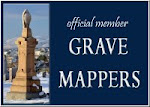



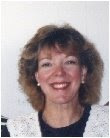



.jpg)
.jpg)
.jpg)



.jpg)
.jpg)
.jpg)


.jpg)